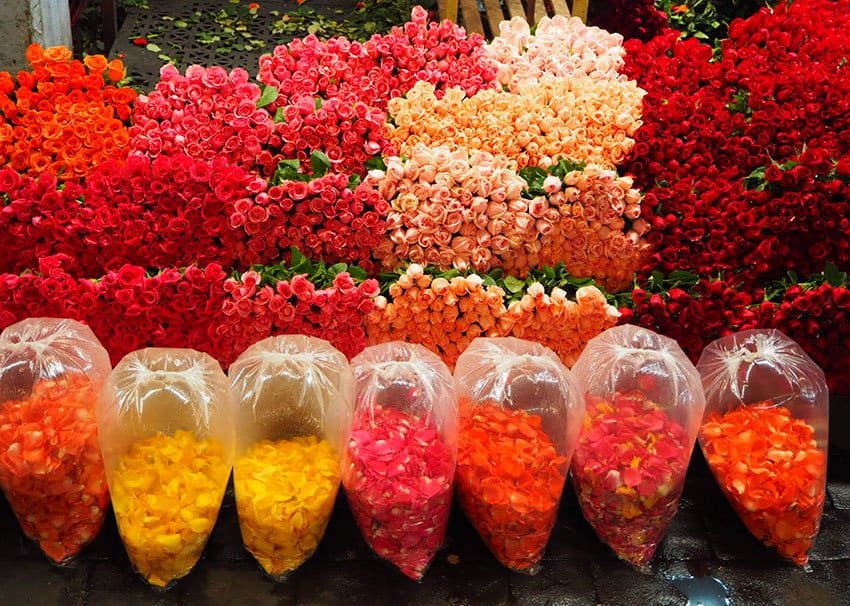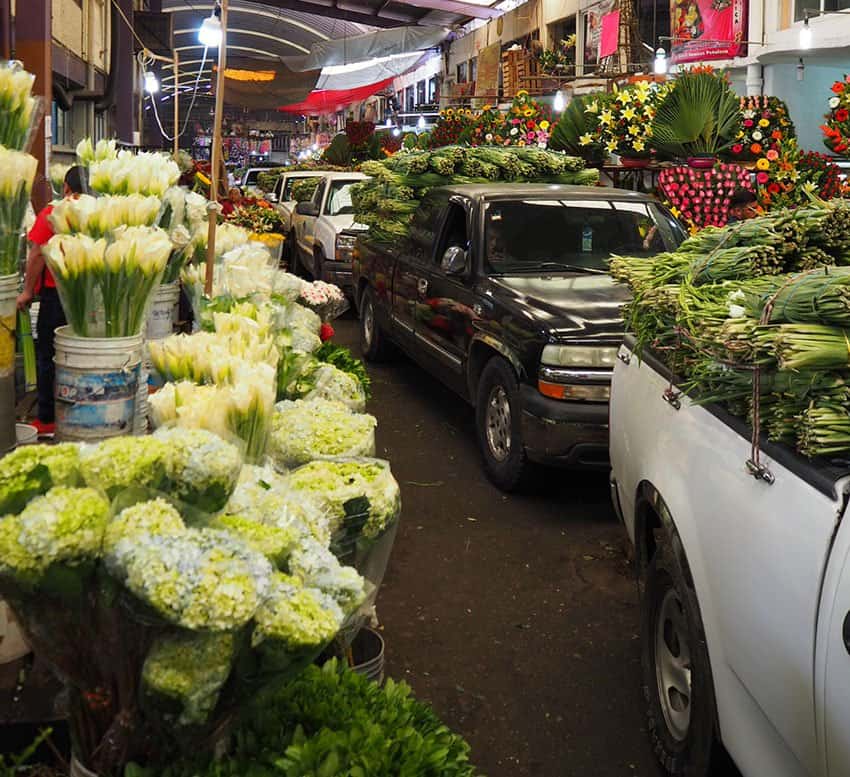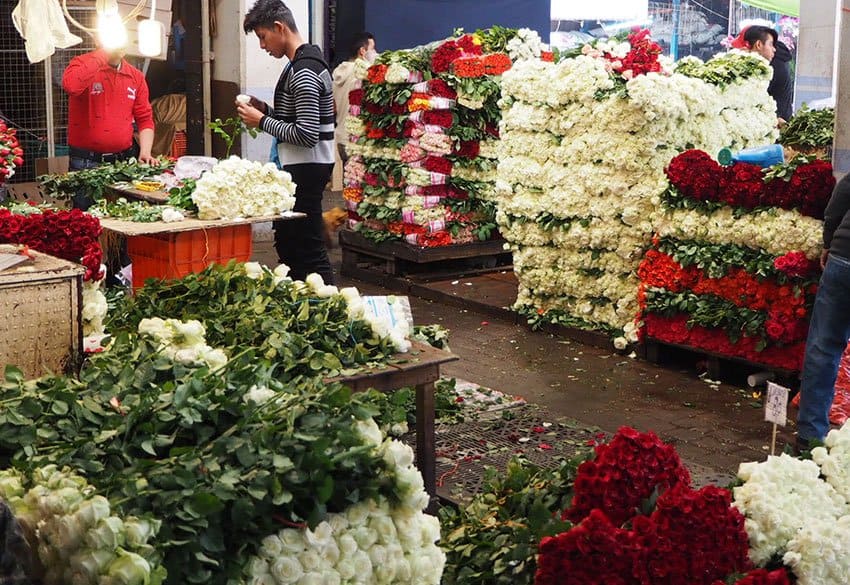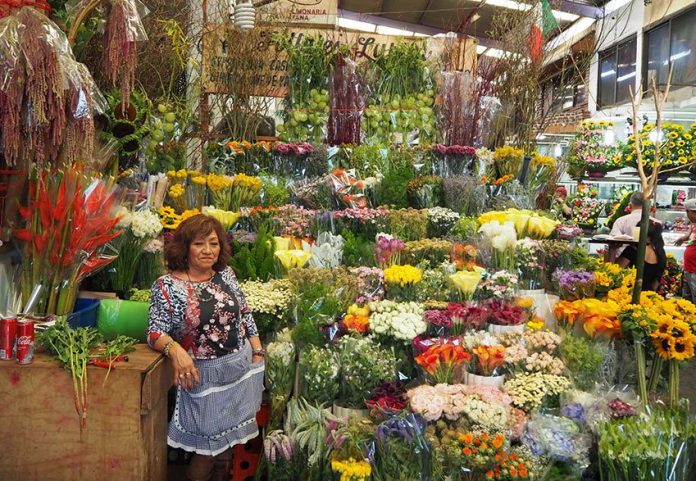When you find yourself in the doghouse at 3:00am, take comfort in knowing there’s a 24-hour flower market in Mexico City.
Surrounded by blacktop and decaying concrete sprawl, among the bus and taxi exhaust of the Mexico City struggle, just south of Centro in Colonia Jamaica, lies an oasis of greenery, THE flower market – Mercado Jamaica.
Entering from Avenida Morelos, Jamaica Market is the usual Mexico City market, albeit an impressive one. The fresh produce veritably spills out from its stands. Watermelon and avocado specialists display their wares sliced into halves as proof of worth. The gleaming red strawberries are the largest I’ve ever seen, like a child bully’s fist.
Piles of beautiful mole, mountains of sweets – piñatas made with the traditional seven points (for the deadly sins) or in the costume of the currently most popular superhero.
Walk a bit deeper into the market and the first fragrance hits the nose, just a bit leafy at first, like fresh-cut grass carried on the wind.

Approaching the back, it grows more apparent, a forest after the rain. And rounding the corner into huge bouquets and mounds of fresh-cut lilies is the true magic scent – a lush jungle of chlorophyll and the sweet aromas of hundreds, possibly thousands of flower varieties intermingled.
Mercado Jamaica must be what perfumists dream of, a warehoused biosphere, the world of flora together under one roof – the concrete jungle, as it were.
Mercado Jamaica opened its doors in 1957 on the grounds where flower sellers already had a large presence. It has just over 1,000 stalls dedicated to the sale of approximately 5,000 types of flowers, foliage and plants. Although there are a number of markets in the city that sell huge numbers of flowers and plants, like Xochimilco, Central de Abastos and San Angel, Jamaica is the only one open 24-hours a day and generally offers a wider variety of imports.
Along the easternmost edge are the large ticket items – the enormous arrangements of roses, chrysanthemums, Gerbera daisies and sunflowers in huge leaf-bottomed boats or massive hearts and crosses.
These are the big event flowers for first communions, weddings, birthdays and funerals. A sign advertises “car bows” for those who just need a giant garnish to go along with their extravagant gift.
Most of these stands are open 24/7, I’m told, because the work is usually custom and intensive. And if you’re a client picking up, you certainly don’t want to lose the funeral flowers to Mexico City traffic.

“What’s the 3:00am scene like?” I ask.
After many brushoffs – “I swear I’m not a snitch, I’m a journalist” – I finally get a kind and studious-looking man to chat, though he prefers his name not be used.
He’s been here for 20 years and specializes in sunflowers. His stand is open 24/7, but these days he works 9:00am to 9:00pm, only seven days a week. “Who’s here at 3:00am?”
He makes a fist, thumb pointed up and tips the thumb toward him to signify “drunk folks, late-night imbibers,” and his legs totter a little to sell it.
“They come to apologize to their girlfriends for something they’ve done,” he says. “But there aren’t many at that time. Regular sales start at about five in the morning.”
Pickup trucks drive through, their beds weighed down with flowers. Rainbows of roses are stacked meters high. Plastic bags of petals grow misty as the sun sneaks through the ceiling, lapping rays of light on them like the hand of God.

This is wholesale area, the vendors generally selling right out of the backs of their trucks to others that will resell them on the street or in neighborhood flower shops. Piles of lilies are worked through expertly with machetes. Vendors constantly splash their goods with water to keep them fresh.
Workers join for lunch at food counters, shooting the breeze and landing well-timed but good-hearted jibes, as only those with years of familiarity can do. The diableros, known for their acumen handling the product, push hand carts full of perfectly stacked flowers out to cars and vans waiting in the parking lot.
There are clearly wealthy ladies in pantsuits, presumably from Polanco or Lomas de Chapultepec; muscled and veiny old men in cowboy hats; and little kids in aprons, stitched with the logo of their company – the future generation of Mercado Jamaica.
I step into one of the booths to ask why the woman has hung a “No Photography” sign. “So other florists don’t steal my designs,” she tells me.
Hector Bialostozky has been creating flower arrangements for restaurants and businesses around Colonia Roma for three years. “Sometimes things are cheaper in Central de Abastos, for example,” he says. “But there’s more diversity of flowers in Jamaica. And you can get things for arranging that Abastos doesn’t have, like vases, foliage, roots, things like that.”
Bialostozky is also a performance artist who creates politically charged works. His flower design company, Flores Magón, is named after noted Mexican revolutionary and anarchist Ricardo Flores Magón. He says he tries to find a political aspect to his flower arranging work.
“Because of my political art background, it was tough to accept my work as a florist. But I like the meditative aspect of flowers, and the contact with people and space, so at least I’m out in the world interacting. And it’s been good to work with the aesthetics – theory of color, composition and the relationship between objects and space. I feel like it’s a continuation of my work in the arts, and it’s a good business.”
“You create relationships with people in Jamaica,” he says. “They begin to know you, charge fairly. Some become friends.”
Among the stands recommended by Bialostozky for the diversity of product is Follaje de Lupita (Lupita’s Foliage) at the market corner of Congreso de la Unión and Guillermo Prieto. Doña Lupita started selling flowers with her mom and grandma when she was 5 and has been at the market since its inception.
Her stand is a massive burst of color, perhaps the most impressive individual scene in the entire market. She says they mostly sell to florists but have a lot of clients that simply enjoy the art of flower arranging. Among her most exotic flowers, she says, are leucos, with tiny orange tips spreading out from the head like a firework exploding, and veronicas, with fuzzy pointed fingers covered with tiny pink and purple petals.
Directly across Guillermo Prieto is Mercado Jamaica Comidas dedicated to selling, almost exclusively, huaraches. The mostly female staff of each stand yelps out, “Huaraches de pollo, huevo, costilla!!!”
At Huaraches Angelita, Angela García has been running the place for 30 years, but began working alongside her mom in ‘57. “I don’t know why the market became known for huaraches,” she says. “It used to be memelas . . . Unintentionally so . . . but now it’s huaraches.”
Along Prieto run the shops with the decorative pieces needed for arranging. Vases of every size and shape, giant dried leaves, decorative bicycles made of tangled vines and branches – all things beautiful and corny – lead the way to Plaza Jamaica, a smaller market for specialty items, like tulips, peonies and orchids.
At Flores de Holanda, the flowers arrive weekly by air from Holland. Tulips generally run 200 to 220 pesos for a dozen or peonies from 220 to 270. They tell me there’s some production in Mexico, but in Holland they can produce all year.
At El Paraiso they show me the plátano tuna stalks full of tiny little bananas topped with pink and purple flowers.
“It’s interesting to see how the flowers change with the seasons.” says Bialostozky. “Sometimes yellow cempasuchitl [marigolds] for Day of the Dead. In winter everything is white and pink with cherry and peach blossoms.”
“When you don’t know anything about the flower world, you think there isn’t much diversity,” he continues. “But when you get to Jamaica, you really realize how many species there are.”
On Tono Street, back at the mercado proper, are the potted plants: weird little succulents, citrus trees, fruit bushes and hundreds of indoor varieties. In search of a San Pedro cactus, I ask a woman who’s clearly been here for decades.
“Yeah, I know that one,” she says. “We don’t have it, but we can get it.”
You can find it all at Mercado Jamaica.
• Mercado Jamaica is located at Guillermo Prieto 45, Colonia Jamaica, open 24/7, 365 days a year.
This is the seventh in a series on the bazaars, flea markets and markets of Mexico City:
- You’ll find art at Mercado Coyoacán, but the main attraction is food
- MercadoRoma, a Mexican public market reimagined for the 21st century
- Tuesdays in Taxqueña, the flea market of musical brotherhood
- Escandón Market is quintessential middle-class CDMX neighborhood market
- A walk through the Mexico City markets of Colonia La Condesa
- The San Juan market, Mexico City’s epicenter for culinary inquisition
